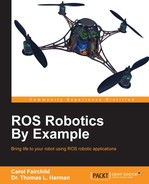This chapter featured information about flying robots that are described as quadrotors or quadcopters because of their four propellers. The first few sections of the chapter described the quadrotors and their flying characteristics as well as the sensors that they might contain. The sensors such as magnetometers, gyroscopes, and accelerometers were discussed with the aim of explaining how they allow the quadrotors to stabilize themselves in the air. Other accessories such as cameras and GPS units were also covered.
The rules for flying safely were presented. These are basically common sense rules such as do not fly over people or pets. Government agencies such as the FAA in the United States govern the use of airspace and those rules should be followed carefully.
The Hector simulator is excellent, particularly for new pilots of quadrotors in that they can be flown in simulation without any danger of real crashes. Details of downloading the Hector software were covered in this chapter. ROS is used for control and message passing to the simulated quadrotor craft.
Finally, two real quadrotors called Crazyflie and Bebop were described and the ROS software to control them was discussed. The Crazyflie is relatively inexpensive and safe to fly, but it embodies many of the principles of more expensive and sophisticated quadrotors. Enjoy your flights!
In the next chapter, Chapter 8, Controlling Your Robots with External Devices, the use of peripheral devices to teleoperate your robot will be considered. Interfacing with joysticks, controller boards and mobile devices are handled by standard ROS packages to help you expedite the process of implementing these devices with your robot.
